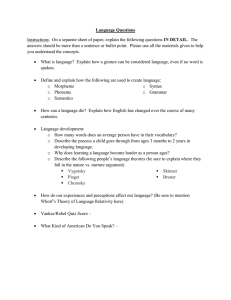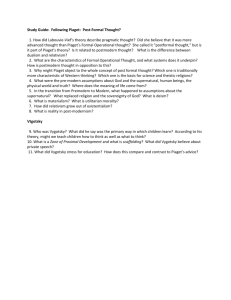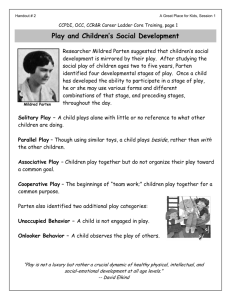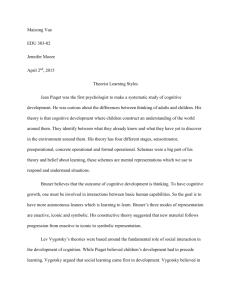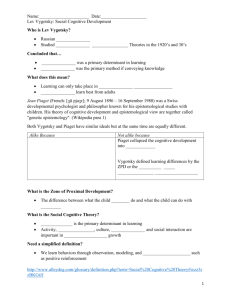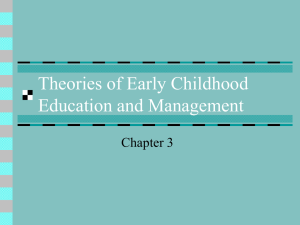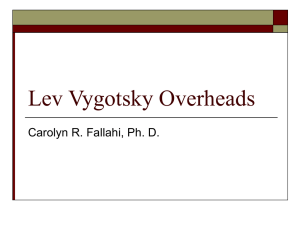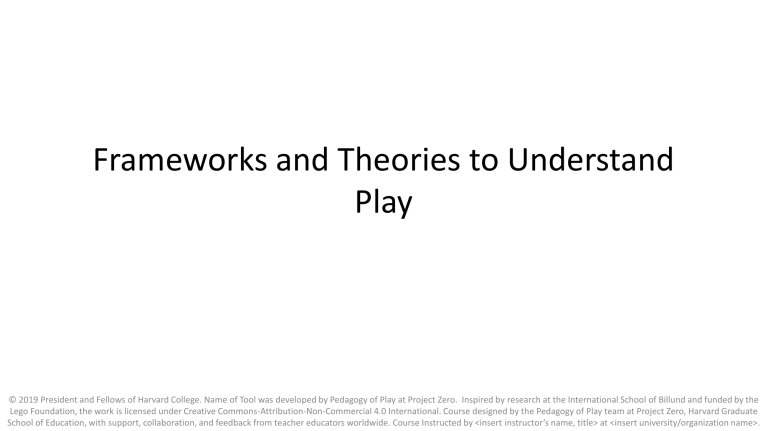
Frameworks and Theories to Understand Play © 2019 President and Fellows of Harvard College. Name of Tool was developed by Pedagogy of Play at Project Zero. Inspired by research at the International School of Billund and funded by the Lego Foundation, the work is licensed under Creative Commons-Attribution-Non-Commercial 4.0 International. Course designed by the Pedagogy of Play team at Project Zero, Harvard Graduate School of Education, with support, collaboration, and feedback from teacher educators worldwide. Course Instructed by <insert instructor’s name, title> at <insert university/organization name>. Agenda • • • • • Playful start Neurology and play – whole group discussion Break Play Theories: The Gameshow Stars and Wishes Playful Start • Choose either Replay or Figure Me Out Identity Web – see instructor guide Play Kit 1. Something to sculpt with (clay, putty, slime, playdough) 2. Something to build/construct with (LEGOs, blocks, popsicle sticks, plastic cups, rocks, sticks) 3. A collection of Beautiful Stuff 4. Paper and something to make marks with (markers, crayons, paints, pastels) • • • • • • 1. 2. 3. 4. 5. Playdough Recipe 1 c flour 1/3 c salt 1 c boiling water 1 Tbsp cream of tartar* 1 Tbsp oil Food coloring if you wish Mix the flour, salt, and cream of tartar Mix together the boiling water, oil, and food coloring Combine everything until mixed, then knead with your hands until smooth Add a little more flour if too sticky Store in an airtight container at room temperature *if you don’t have cream of tartar, you can skip this and just keep your playdough in the fridge. It won’t keep as long but will work ok Frameworks and Theories to Understand Play What is play? “Remembering what play is all about and making it part of our daily lives are probably the most important factors in being a fulfilled human being. The ability to play is critical not only to being happy, but also to sustaining social relationships and being a creative, innovative person. Brown, S. & Vaughan, C. (2009) What is play? I hate to say… • Apparently purposeless (done for it’s own sake, not for survival) • Voluntary • Inherent attraction • Freedom from time (sense of flow) • Diminished consciousness of self • Improvisational potential • Continuation desire From Brown & Vaughan, 2009 (LEGO Foundation, 2017) Indicators of Playful Learning Ubuntu Ownership Curiosity Playful Learning International School of Billund, Denmark 6 United States schools Enjoyment Meaningful Empowering 3 South African Schools Playful Learning Joyful Types of play • • • • • Fantasy/imaginative play Constructive play Games with rules Rough-and-tumble play Taboo play Now think about your play autobiography – what type of play were you engaged in? Stages of play (Parten, 1932) • • • • • • Unoccupied behavior Onlooker behavior Solitary play Parallel play Associative play Cooperative play “Traditionally, play has been conceptualized within a narrow band of theories on cognitive and social development (e.g., Piaget’s cognitive developmental theory; Parten’s play typologies) that were presumed to have universal applications. More recent conceptualizations of childhood development in the areas of cultural psychology and early education (e.g., Greenfield et al. 2003; Chaudhary and Tuli 2010) have proposed different cultural pathways to achieve common developmental goals across cultures…In most cases, the theoretical perspectives converge or intersect regarding play as a universal cultural activity. However, they do diverge on the developmental significance of play. Its benefits for the development of cognitive and social skills in children in different cultural settings are only now beginning to be discerned…Whereas, in some cultural communities, a strong case is made for the connection between play activities and practicing and learning culturespecific modes of behaviors, in others, children learn through a mixture of work and play or by observing others and replicating their activities.” (Roopnarine et al., 2015, p.2) What happens in the brain during play? Your Brain Your Brain on Play Your Brain on Play Play gives access to content and higher levels of thinking for a variety of learners. -Mraz, Porcelli, & Tyler (2016) Play and Neuroscience Discussion What stood out to you in the neuroscience and play report? What are you curious about? Two ways to participate: Please raise your hand to speak, or add comments/questions to the chat Extra resource • http://playtime.pem.org/play-digest-this-is-your-brain-onplay/ Theories for Understanding Play Play Theories: The Gameshow Playing the Gameshow • Teams take turns being Play Analysts or Judges. • Play Analysts: Work with your team to come up with the most convincing in-character analysis of the play episode. You have 90 sec to prepare each round. Share your response (in character, of course). – Bonus point in each round for correctly identifying the type of play (see Mraz et al. Chapter 2) – Second bonus point for making a substantive connection to the the neurology report • Judges: award a point to the team with the most theoretically sound and in-character response. • Winning the game: The team with the most points at the end of the game wins fame and fortune (or at least a fun applause of their choice) Pick your Team! • • • • • • • • • Team Vygotsky Team Piaget Team Bateson Team Corsaro Team Bruner Team Parten Team Paley Team Bruce Team Skovbjerg Bateson – play frames What roles are children taking on? Is there role flexibility at play? Do the events in the play frame relate to their real world? How? Vygotsky – play as a ZPD What pivots (play objects) are involved? In what ways do adults scaffold play? How is play socially constructed? Piaget – play as assimilation How are children acting on objects to assimilate knowledge? Are children transforming objects or themselves during play? Bruner – problem solving (Frost p.40) What domains of learning are children developing in this play? Are children acting in ways that minimize consequences, compared to actions in the real world? Are tools being used to solve problems? Corsaro - peer culture and play talk (Frost p.45 table) What types of play talk took place in this play episode? What do you think about the social dynamics/power relationships here? Paley – storytelling, culture, and language development What stories are children telling during their play? As a teacher researcher, what are you learning about these children by observing their play? Bruce – 12 features of play What features of play do you see in this example? Skovbjerg – play moods What play moods do you observe in this example? Round 1 • • • • Team Bruner Team Parten Team Vygotsky Team Bruce Insert video link to video library clip of your choice here Round 2 • Team Corsaro • Team Paley • Team Bateson Insert video link to video library clip of your choice here Round 3 • • • • Team Parten Team Piaget Team Skovbjerg Team Bruce Insert video link to video library clip of your choice here Round 4 • Team Paley • Team Piaget • Team Vygotsky Insert video link to video library clip of your choice here Round 5 • • • • Team Bateson Team Corsaro Team Bruner Team Skovbjerg Insert video link to video library clip of your choice here “Remember that theory should help you think about and understand what you are seeing children do, and that no one theory will explain it all.” Frost (2012) p.53 Star and Wish • Add link here if you choose to do star/wish reflections digitally
